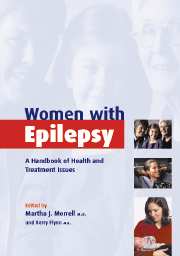Book contents
- Frontmatter
- Contents
- List of contributors
- Part I The woman with epilepsy
- Part II Epilepsy diagnosis and treatment
- Part III Hormones and the brain
- Part IV Health challenges for women with epilepsy
- 14 Reproductive health for women with epilepsy
- 15 Sexual dysfunction in epilepsy
- 16 Bone health in women with epilepsy
- 17 Psychiatric complications in epilepsy
- Part V Family planning, pregnancy, and parenting
- Part VI Living well with epilepsy
- Appendix: The Epilepsy Foundation's Campaign for Women's Health: bringing help and hope to women with epilepsy
- Index
- References
16 - Bone health in women with epilepsy
from Part IV - Health challenges for women with epilepsy
Published online by Cambridge University Press: 02 November 2009
- Frontmatter
- Contents
- List of contributors
- Part I The woman with epilepsy
- Part II Epilepsy diagnosis and treatment
- Part III Hormones and the brain
- Part IV Health challenges for women with epilepsy
- 14 Reproductive health for women with epilepsy
- 15 Sexual dysfunction in epilepsy
- 16 Bone health in women with epilepsy
- 17 Psychiatric complications in epilepsy
- Part V Family planning, pregnancy, and parenting
- Part VI Living well with epilepsy
- Appendix: The Epilepsy Foundation's Campaign for Women's Health: bringing help and hope to women with epilepsy
- Index
- References
Summary
Women are at greater risk for osteoporosis than men. For some years, physicians have been concerned that women with epilepsy are at particular risk for this condition, which is associated with bone fractures. Osteoporosis (thinning of the bones) may be caused by some antiepileptic drugs. Unfortunately, the available scientific information cannot tell health-care providers which medications cause bone disease and which of the drugs may be safer to use.
Dr Robert Marcus is a bone specialist who is an expert in bone health in women with epilepsy. He is a former Professor of Internal Medicine and Endocrinology at Stanford University. We have collaborated in a study evaluating bone density and bone turnover in women with epilepsy. This study, when it is complete, promises to provide helpful information about the effect of particular antiepileptic drugs on bone.
In the meantime, we recommend that all women with epilepsy employ good bone health practices; that is, regular, gravity-resisting exercise, good nutrition, and adequate calcium and vitamin D intake. Women with epilepsy should also have their bone density checked at least at menopause, if not earlier. More bone health recommendations will come out of the research being conducted.
MJMSome people with epilepsy have an increased risk for a condition of the skeleton called osteoporosis. The purpose of this chapter is to clarify the nature of this relationship, to outline its possible causes, and to discuss current approaches to treatment.
- Type
- Chapter
- Information
- Women with EpilepsyA Handbook of Health and Treatment Issues, pp. 164 - 170Publisher: Cambridge University PressPrint publication year: 2003

